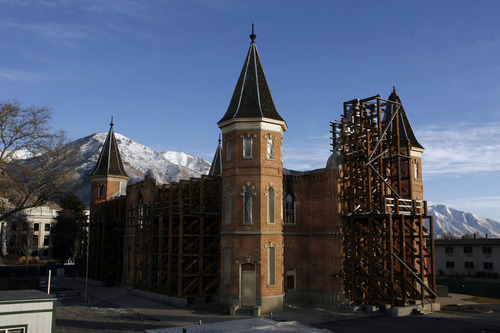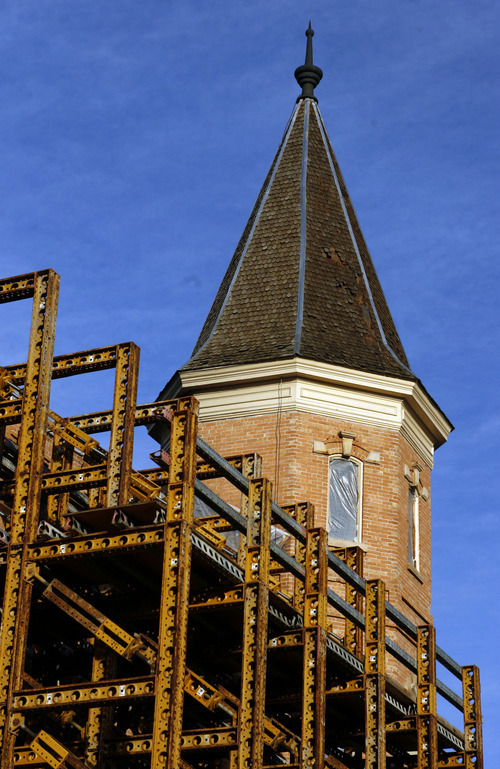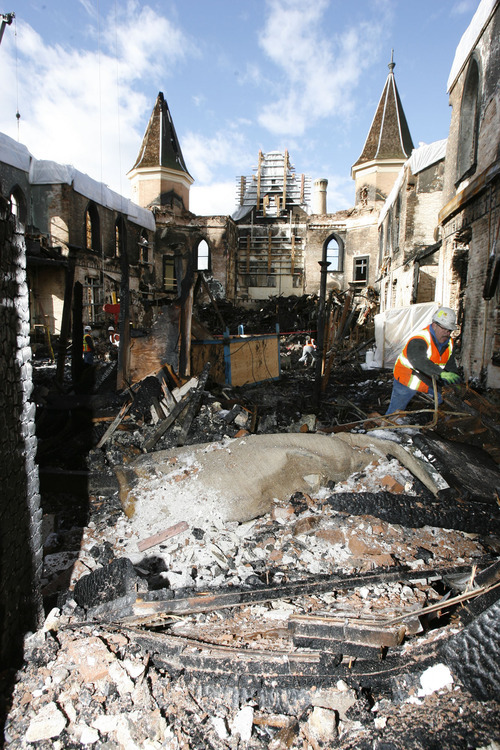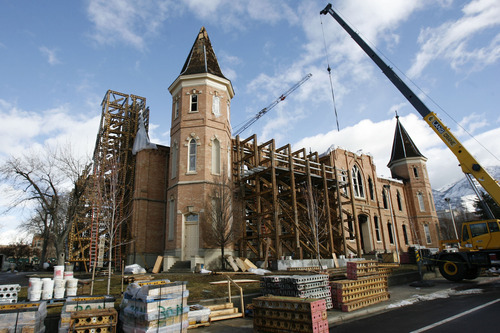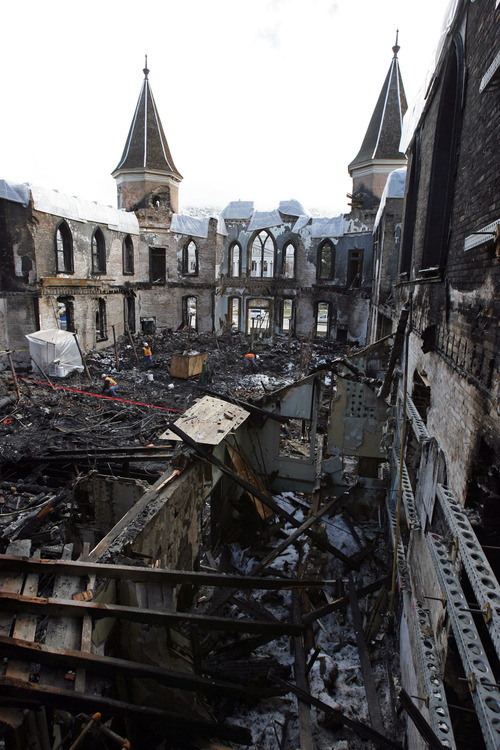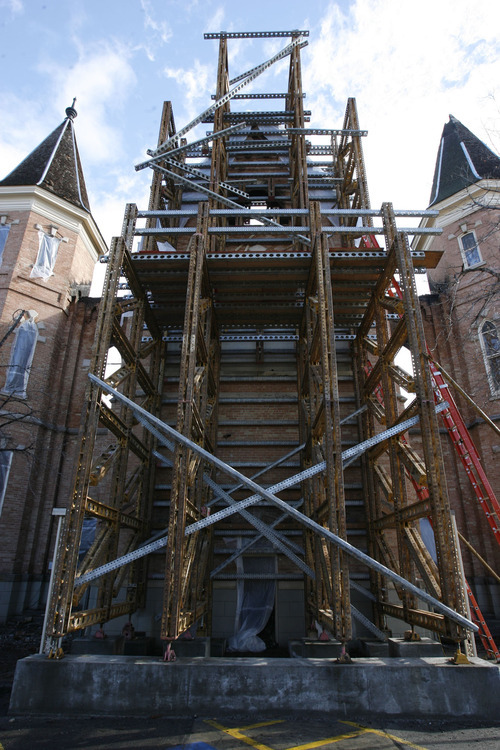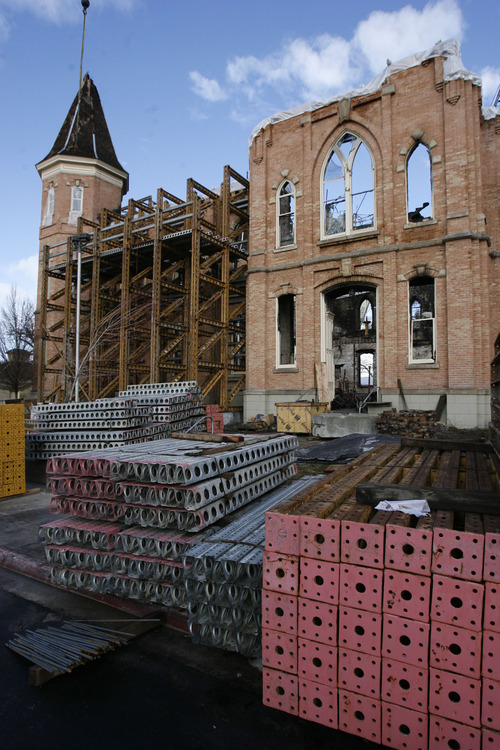This is an archived article that was published on sltrib.com in 2011, and information in the article may be outdated. It is provided only for personal research purposes and may not be reprinted.
Provo • It greeted presidents and prophets. It welcomed singers and speakers. It staged joyous school commencements and solemn religious assemblies.
For decades, it burned with the fires of faith and community. Then came the flames of Dec. 17, 2010, threatening to consign its lush legacy to fading memories and dusty books.
But the Provo Tabernacle won a rebirth Oct. 1, when the LDS Church announced plans to restore the gutted landmark.
And now, Jessie Embry is on a mission to preserve the spired structure's rich history before its mission changes — to that of Mormon temple.
Embry, associate director of the Charles Redd Center at Brigham Young University, and a team of BYU students are gathering oral histories and photographs of the tabernacle and downtown Provo.
The project started with Nu Skin Enterprises' plans to expand its headquarters downtown. To make way for the expansion, Provo sold Nu Skin a block of 100 West, and the company tore down two buildings. The city deemed that those structures lacked historic significance to warrant saving.
Embry, then a member of the city's Landmarks Commission, feared not enough was being done to preserve history in a changing downtown. That is when she conceived of the history project.
The undertaking was still in the "thinking stages" when a lighting contractor failed to disconnect a high-intensity lamp in the tabernacle's attic last December, igniting a blaze that consumed the interior of the 128-year-old building.
Although the fire was an emotional moment for Provo residents, many of whom braved subfreezing temperatures to witness crews battle the blaze, it was personal for Embry. Her Mormon stake includes the tabernacle, and she wanted the building's history preserved as much as the building itself. Her stake president asked if she could do a history project on the tabernacle in the wake of the fire, so Embry added it into the downtown endeavor.
"We had two projects become one," Embry said.
Her work involves students interviewing residents about their memories of downtown and the tabernacle. The students, Embry said, transcribe the interviews and give their subjects a copy. They also copy any photos or other related documents.
The goal: Create a book for BYU's library and a display for Nu Skin's new offices. The work will also be shared with the LDS Church, which is documenting the tabernacle's history.
D. Robert Carter, a historian who has written extensively on Provo's past, has helped by giving Embry's students a tour of downtown and pointing out where historic buildings once stood. That allows them to better understand what they're told in interviews.
Carter said today's downtown certainly is not the same one in which he grew up. Stores have either been replaced or razed for other projects, such as the Utah County Convention Center.
"My hometown is almost gone," Carter said. "I always think it is worthwhile to preserve what used to be, so people can compare it to what we now have."
Carter fondly recalls his parents taking off in their 1948 Nash to watch passers-by in an era when "going downtown" meant dressing up.
In her oral history, Kathryn Matson recounts memories of Taylor Brothers' department store, just west of where the convention center is being built, and the "awesome" Toyland that filled the third floor at Christmastime.
Kathryn S. Allen, executive director of Downtown Business Alliance of Provo, fully supports preserving the area's history,
"History is a common denominator for all of us," Allen said. "It will always be a fascinating subject to bring people together."
And the LDS tabernacle, Allen said, was the heart of downtown — as a sacred edifice, a community gathering place and a home to arts programming.
"It is where people have historically celebrated events in the city," Embry said.
Besides hosting LDS conferences — including several General Conference sessions during the height of anti-polygamy persecution — the tabernacle has been a venue for graduations, concerts, recitals and public speeches.
One of its first events was an 1885 memorial service for Ulysses S. Grant.
On July 24, 1914, former President William Howard Taft spoke from the tabernacle's podium during a Pioneer Day celebration.
Carter, the historian, sang there in a children's program, graduated from high school there and attended many a concert.
The building boasted a unique setting for concerts, especially in the spring, when late-afternoon sunshine would illuminate the stained-glass windows.
Carter said Sergei Rachmaninoff performed in the tabernacle in 1938. The legendary 20th-century Russian composer and pianist stopped playing when one of Walter C. Orem's electric trains went by outside. Once the train and its ringing bell passed, he resumed playing.
Carma DeJong Anderson, in an interview with one of Embry's students, recalled a performance by the Italian bass Ezio Pinza, best known for his performance in Rodgers and Hammerstein's "South Pacific."
As Pinza sang "Some Enchanted Evening," Anderson recalled the opera star got unexpected attention from an uninvited fan.
"In the middle of [the song], as he was opening his mouth, a bat flew out of the ceiling of the tabernacle and circled around him," Anderson recalled. "... The bat started diving for his open mouth. Then he would pull off just before he hit his mouth. Then he would go out and then he would dive toward the sound again."
The tabernacle's custodians grabbed mops and brooms to shoo away the bat, causing the singer to halt. Eventually, the bat, tired of being swatted at, retreated, and Pinza continued his concert.
For now, Embry and her history sleuths are continuing their work, set for completion around April.
And in coming years, after crews have restored the edifice — including a center spire that was removed in 1917 — and the open-house crowds have left, the Provo's proud tabernacle will begin building new memories as a place for Mormonism's most sacred sacraments and only for devout Latter-day Saints.
Many will appreciate the coming shift to temple status, said Allen, of the Downtown Alliance, but others will see it as the loss of a gathering place.
"People will look at [the restored tabernacle] and say, I remember when … " Allen said. "It now becomes a very different place."
dmeyers@sltrib.com Twitter: @donaldwmeyers facebook.com/donaldwmeyers —
How to help
P To volunteer to be interviewed for the Provo Tabernacle and downtown history project, contact Jessie Embry at 801-422-7585 or historicdowntownprovo@gmail.com. Or go to its Facebook page at http://goo.gl/OML9V —
The bat and the bass
[Bass singer] Ezio Pinza had a piano for his accompanist. I was sitting on the front row on the left side of the ground floor of the middle section. He was doing most of his singing out on that side. Sometimes he would walk across the stage dramatically and sing out to the other side. Then he came back again.
He was in the middle of his concert. He started to go into Broadway songs. He sang "Some Enchanted Evening" with his beautiful accent. In the middle of it, as he was opening his mouth, a bat flew out of the ceiling of the tabernacle and circled around him. The audience was going, "Ah ah ah!" We were more and more worried. The bat started diving for his open mouth. Then he would pull off just before he hit his mouth. Then he would go out and then he would dive toward the sound again. I guess the bat was mesmerized by the sound.
At that point, it was so hilarious because from the front rows, Harold R. Clark and other men of the tabernacle who took care of the tabernacle all jumped up. They ran back and got brooms. They put on this show of trying to bat the bat away with their brooms and their fluffy mops. It was hilarious. As soon as the bat was in the sight range of the accompanist, the accompanist stopped. Ezio Pinza stopped. They looked around in desperation. These men were desperately flailing the brooms and the mops trying to get rid of the bat. I think they just wore out the bat. He was just too tired to make any more dives at us with those mops flying around. So the bat finally went away.
Ezio Pinza, with his great aplomb with his experience on the stage, came back to his position. They went right on with the song of "Some Enchanted Evening." It was just beautiful. It was so funny. The audience [members] all had their hands over their mouths, so they wouldn't laugh at what the men were doing. They didn't want to be impolite to this visiting musician and his accompanist. But they were just dying, laughing under their clapped hands over their mouth. They were ready to pop with laughter. ...
Finally, the bat went away and disappeared. Nobody knows where he came from. He may have come in an open door. In those summer concerts, they had the doors wide open. He may have swooped in from some other old place. ... I'm not sure that he came from anywhere in the tabernacle because we didn't have any openings in the ceiling that high. It was so unexpected but so funny.
Carma DeJong Anderson


